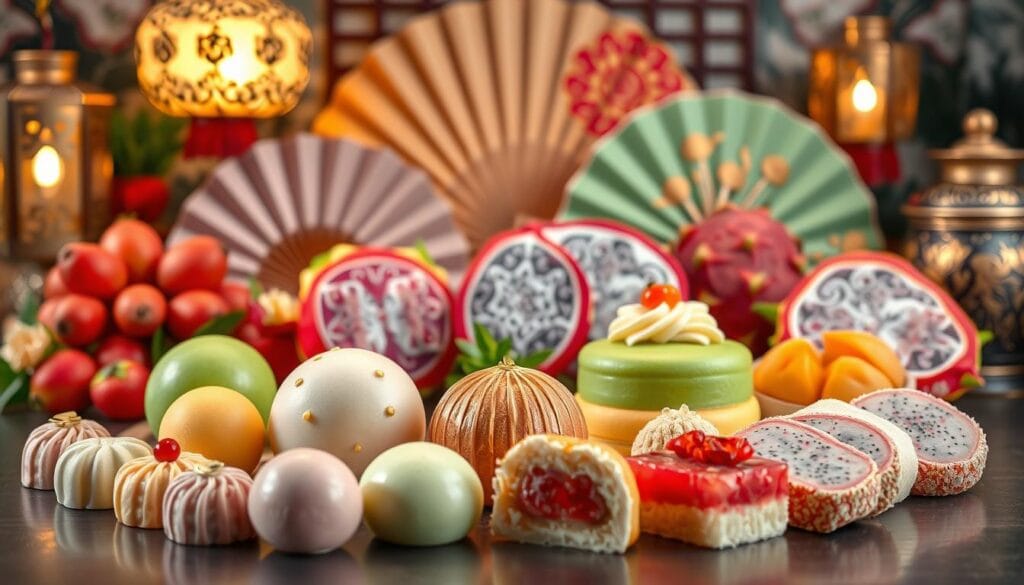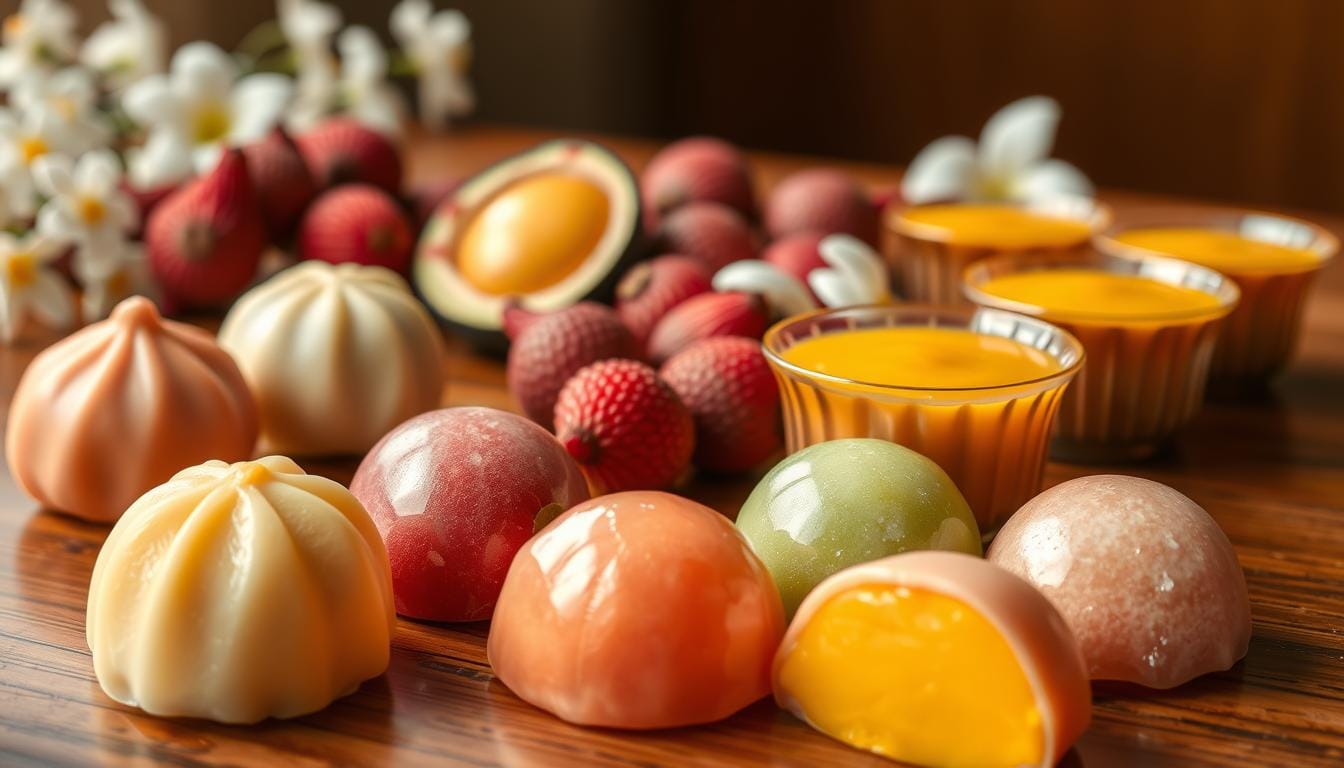Discover the irresistible world of Asian desserts, from sweet mango sticky rice to creamy matcha treats. Learn how to make these traditional favorites in your kitchen

Get ready for a delicious adventure through Asian desserts. These treats are more than just sweets. They tell stories of culture, tradition, and new ideas. Each dessert has its own tale, showing off local flavors and cooking skills passed down through generations.
Asian desserts are incredibly varied, from light rice cakes to creamy delights. They offer tastes and textures that surprise and delight. These desserts challenge what we think of as traditional sweets, bringing new flavors to our plates.
If you love food or just want to try something new, this guide is for you. It will open your eyes to the amazing world of Asian desserts. Prepare to enjoy flavors that mix food, art, and culture in a way you’ve never experienced before.
Key Takeaways
- Asian desserts offer unique flavor combinations
- Each recipe tells a cultural story
- Texture plays a crucial role in dessert experience
- Ingredients are often locally sourced and seasonal
- Desserts reflect deep culinary traditions
Exploring the Rich Heritage of Asian Dessert Traditions
Asian desserts are a journey through time and taste. They mix old traditions with new flavors. Each dessert tells a story of culture, local ingredients, and cooking skills passed down for generations.

The variety of Asian desserts shows the rich diversity of the region. From Japan’s rice treats to Southeast Asia’s coconut sweets, these desserts celebrate cultural heritage.
Regional Influences on Sweet Creations
Different places add their own twist to desserts:
- China: Focuses on balance between sweet and subtle flavors
- Thailand: Uses tropical ingredients like pandan and coconut
- Japan: Values precision and elegant presentation
- Vietnam: Mixes French and traditional cooking styles
Cultural Significance in Celebrations
“Desserts are the poetry of food, telling stories of tradition and connection.”
Desserts are key in many Asian celebrations. Mooncakes for the Mid-Autumn Festival, mochi for Japanese New Year, and sweet sticky rice for Chinese weddings show their deep cultural ties.
Traditional Preparation Methods
Making traditional Asian desserts requires skill and patience. Pandan leaves, for example, add a special scent and color to many sweets.
| Region | Traditional Technique | Signature Dessert |
|---|---|---|
| Japan | Steaming | Wagashi |
| Thailand | Coconut milk reduction | Mango Sticky Rice |
| Philippines | Slow cooking | Bibingka |
Learning about these traditions helps us see the beauty of Asian desserts. It’s not just about taste, but also about the stories and skills behind them.
Essential Ingredients in Asian Sweet Treats

Asian desserts are a colorful mix of flavors. Each ingredient has its own story. Exploring these treats, you’ll find amazing ingredients that make simple recipes special.
Coconut is a key player in many desserts. Its creamy texture and unique taste are essential. It’s found in many forms across different cuisines.
- Coconut milk
- Shredded coconut
- Coconut cream
- Coconut sugar
Other important ingredients also shape Asian desserts:
- Rice flour: Makes mochi and other sweets chewy
- Pandan leaves: Adds a green color and a special scent
- Red bean paste: A favorite filling in East Asian sweets
“Ingredients are the storytellers of culinary traditions” – Chef Ming Tsai
Every ingredient has its own cultural value. They turn simple recipes into journeys of taste and tradition.
Mochi Magic: Japanese Rice Cake Delicacies
Dive into the world of mochi, a beloved Japanese dessert. It has captured hearts worldwide. These delightful rice cakes blend tradition with modern culinary creativity. They offer a unique taste experience that goes far beyond ordinary sweets.
Mochi represents a culinary art form. It transforms simple rice into an extraordinary treat. Crafted from pounded glutinous rice, these soft and chewy delicacies come in countless variations. They will tantalize your taste buds.
Delectable Mochi Fillings
Explore the diverse world of mochi fillings that make these treats so special:
- Classic red bean paste (azuki)
- Creamy ice cream centers
- Fresh fruit compotes
- Nutty sesame fillings
- Matcha green tea cream
Contemporary Mochi Innovations
Modern chefs have reimagined mochi. They’ve created exciting new versions that appeal to global palates. From ice cream-filled mochi to gourmet flavor combinations, these innovations keep the traditional treat fresh and exciting.
Seasonal Mochi Delights
Mochi celebrates the changing seasons with special varieties. It reflects Japan’s rich culinary traditions. Enjoy cherry blossom-inspired spring mochi, refreshing summer fruit versions, and warming autumn-themed treats that showcase local ingredients.
Whether you’re a dessert enthusiast or curious foodie, mochi offers a delightful journey. It takes you into Japanese culinary artistry that continues to evolve and surprise.
Matcha-Based Desserts: Green Tea Goodness
Matcha has changed the dessert world with its bright green color and special taste. This green tea powder makes simple sweets into amazing treats that please the eyes and taste buds.
Exploring matcha desserts, you’ll find many tasty options. They show how versatile this amazing ingredient is. From classic Japanese sweets to new creations, matcha adds a unique earthy sweetness to desserts.
- Matcha ice cream with creamy, smooth texture
- Delicate matcha mochi with soft, chewy exterior
- Light and airy matcha chiffon cakes
- Crisp matcha cookies with subtle green tea notes
People who care about health love matcha desserts. They are full of antioxidants and help boost metabolism. These green tea treats are not just delicious but also good for you.
“Matcha transforms ordinary desserts into extraordinary culinary art” – Tokyo Pastry Chef
Today’s pastry chefs keep trying new things with matcha. They mix old ways with new ideas. Whether you love green tea or just want to try something new, matcha desserts offer a special and unforgettable taste adventure.
Red Bean and Taro Creations: Traditional Favorites
Asian desserts are known for their wide range of flavors. Red bean and taro are two favorites that have won hearts for many years. They add special textures and carry deep cultural meanings to desserts.
Explore the world of red bean and taro. These two ingredients turn simple desserts into amazing culinary experiences. They are great for both old and new Asian sweets.
Sweet Red Bean Paste Delights
Red bean paste is a key part of many Asian desserts. It’s found in:
- Traditional mochi fillings
- Steamed buns and pastries
- Ice cream and frozen treats
- Layered cakes and traditional confections
Taro Dessert Innovations
Taro adds a subtle, nutty taste that makes desserts special. It’s perfect for new culinary adventures:
- Creamy taro bubble tea
- Taro-flavored ice cream
- Traditional Asian puddings
- Baked goods with unique taro fillings
Fusion Culinary Experiences
Modern chefs are mixing red bean and taro in new ways. They blend old techniques with modern cooking. This is seen in fancy ice cream shops and top restaurants, inspiring new dessert ideas.
Red bean and taro are more than ingredients. They connect us to our culture and spark culinary creativity.
Coconut and Pandan: Tropical Sweet Sensations
Southeast Asian cuisines celebrate two iconic ingredients: coconut and pandan. These ingredients turn ordinary desserts into extraordinary tropical experiences. They capture the essence of warm, lush landscapes and create unforgettable sweet sensations.
Coconut adds a rich, creamy texture to desserts. Pandan offers a unique, fragrant green essence that elevates simple treats. Together, they create magical culinary moments that transport you to tropical paradises.
- Pandan cake: A vibrant green sponge cake with delicate aromatics
- Coconut jellies: Refreshing, translucent desserts perfect for hot days
- Coconut pandan pudding: A smooth, silky treat blending two iconic flavors
Traditional Southeast Asian kitchens use these ingredients in many ways. Coconut is used as milk, cream, or shredded flesh. Pandan leaves infuse desserts with their distinctive green color and subtle nutty taste.
The magic of coconut and pandan lies in their ability to transform simple ingredients into extraordinary culinary experiences.
You’ll find these ingredients in both classic and modern desserts. They prove their versatility and timeless appeal. From street vendors to high-end restaurants, coconut and pandan continue to inspire chefs and delight dessert enthusiasts across generations.
Tapioca and Lychee: Textural Adventures
Asian desserts are full of unique textures and flavors. Tapioca and lychee are two special ingredients that make desserts unforgettable. They add unexpected joys to your taste buds, creating lasting memories.
Explore the amazing world of tapioca and lychee. These ingredients have changed Asian desserts forever. They let chefs and home cooks create amazing treats that amaze and delight.
Bubble Tea and Dessert Crossovers
Bubble tea has taken the world by storm, thanks to tapioca. These chewy pearls make drinks and desserts fun to eat. You’ll love these tasty twists:
- Classic milk tea with tapioca pearls
- Fruit-infused bubble tea
- Tapioca-topped ice cream
- Frozen bubble tea desserts
Fresh and Preserved Lychee Treats
Lychee adds a sweet, floral taste to desserts. Whether it’s fresh or preserved, lychee makes sweets even better. You’ll find it in:
- Jellies and puddings
- Sorbet and ice cream
- Pastries and cakes
- Refreshing summer drinks
Creative Tapioca Applications
Tapioca is a blank canvas for desserts. Its neutral taste and texture let chefs get creative. They turn ordinary desserts into amazing experiences.
“Tapioca transforms ordinary desserts into extraordinary culinary adventures.” – Dessert Chef Insights
Tapioca and lychee keep inspiring new desserts. They add a special touch to every treat. Every bite is a journey of taste and texture.
Black Sesame Sweets: Nutty Indulgences
Black sesame has become a star in Asian desserts, offering a rich, nutty taste. It turns simple sweets into amazing culinary experiences. This blend of tradition and modern taste is truly special.
Explore the world of sesame-based desserts. They show how versatile this amazing ingredient is. From old favorites to new creations, black sesame adds depth and complexity to desserts.
- Traditional Black Sesame Desserts:
- Tangyuan (glutinous rice balls)
- Black sesame soup
- Sesame mochi
- Modern Sesame Interpretations:
- Black sesame ice cream
- Sesame macarons
- Innovative bakery creations
Sesame is also great for your health. It’s full of minerals, antioxidants, and healthy fats. So, you can enjoy these tasty treats without feeling guilty.
Chefs are always finding new ways to use sesame. They mix traditional Asian methods with global flavors. Whether you love desserts or just enjoy trying new foods, black sesame sweets are a must-try.
Must-Try Contemporary Asian Dessert Innovations
Asian desserts are changing fast, mixing old flavors with new cooking methods. Today’s sweets are getting famous online and through creative twists on old recipes.
Modern Asian desserts are breaking new ground, offering exciting tastes for food lovers. They show how tradition and innovation can meet in a tasty way.
Social Media Trending Treats
The internet has changed how we see desserts. Things like Japanese souffle pancakes and clear raindrop cakes are huge on Instagram. They’re not just tasty; they’re also great for sharing and start conversations worldwide.
- Jiggly souffle pancakes
- Crystal-clear raindrop cakes
- Intricate mirror glazed desserts
Fusion Dessert Phenomena
Chefs are now mixing things up, combining different tastes. This fusion of Asian and Western flavors has created new and exciting tastes.
- Matcha cheesecake
- Black sesame tiramisu
- Mochi donuts
Health-Conscious Adaptations
Today’s desserts are also getting healthier. Chefs are making lighter versions of old favorites, using less sugar and different ingredients.
- Low-sugar mochi
- Protein-enriched traditional recipes
- Gluten-free rice cake variations
These new trends show how Asian desserts are always changing. They offer fun experiences that honor tradition but also welcome new ideas.
Conclusion
Asian desserts are more than just sweet treats. They take you on a journey through culture, innovation, and taste. From Japan’s delicate rice cakes to Southeast Asia’s rich coconut desserts, they share stories of heritage and creativity.
Exploring Asian desserts opens up a world of depth and complexity. You might be drawn to matcha sweets, tapioca treats, or black sesame delights. Each bite is a window into the region’s culinary traditions.
Asian dessert makers are always innovating. They mix old techniques with new flavors, appealing to everyone. This makes their creations truly special.
Remember, these desserts are cultural expressions. They show the beauty of tradition and creativity. Your taste buds will love the journey through these sweet discoveries.
Don’t miss the chance to explore Asian desserts. Each region and recipe has its own story. Discover the sweetness of these unique tales.
FAQ
What makes Asian desserts unique compared to Western sweets?
Asian desserts stand out with their unique flavors. They often use matcha, red bean, coconut, and pandan. These desserts have less sugar and focus on subtle tastes and interesting textures.
Are mochi desserts only available in Japan?
Mochi desserts started in Japan but are now loved worldwide. You can find them in many Asian restaurants and even in grocery stores. They come in flavors like matcha, red bean, taro, and coconut.
Is bubble tea considered a dessert?
Bubble tea is a mix of a drink and a dessert. It has tapioca pearls and sweet flavors, making it a treat for both drink and dessert lovers.
Are Asian desserts typically very sweet?
Asian sweets are not as sweet as many Western desserts. They use ingredients like taro, sesame, and lychee for balanced flavors. This makes them less sweet overall.
What are some vegan-friendly Asian dessert options?
Many Asian desserts are vegan or can be made vegan. Look for ones with coconut milk, pandan leaves, red bean paste, and tapioca pearls. Mochi and many Southeast Asian jellies are vegan-friendly.
How healthy are traditional Asian desserts?
Traditional Asian desserts are often healthier. They use matcha, black sesame, and coconut for their ingredients. While they should be eaten in moderation, they offer more health benefits than Western sweets.
What is the most popular Asian dessert internationally?
Mochi and bubble tea are big hits worldwide. Matcha desserts are also trendy, with matcha ice cream and cakes being popular in cafes and restaurants.
Can people with gluten sensitivities enjoy Asian desserts?
Many Asian desserts are gluten-free or can be made that way. Mochi, tapioca puddings, and coconut-based sweets are great for those avoiding gluten.

